

Context:
A New research suggests that Earth’s sister planet’Venus’ may have been home to microbial life billions of years ago due to tectonic activities.
About
Venus and Plate Tectonics:
- Venus, often referred to as Earth’s sister planet, may have experienced tectonic activity about 5 billion to 3.5 billion years ago.
- Plate tectonics may have been instrumental in creating its carbon dioxide- and nitrogen-rich atmosphere on Venus.
- The planet’s atmospheric composition is mainly composed of Carbon dioxide (96.5 per cent) and Nitrogen (less than 3.5 per cent).
|
Plate Tectonics:
|
Recent Findings on Venus:
- Life on Venus: The ancient Venus may have been home to microbial life due to tectonic activities and similar to the Earth.
- Halt of tectonic movement: The plate tectonics would have likely ended on Venus after it lost water and its atmosphere got too hot and thick. This process may have dried up the necessary ingredients that make tectonic movements possible.
- Stagnant lid model: Venus may have transitioned from limited tectonic movement early in its history to the stagnant lid model that exists today. A stagnant lid means its surface has only a single plate with minimal amounts of movement to release gases into the atmosphere.
- Plate Tectonics and Planet’s habitability: According to Researchers, the planets may transition in and out of different tectonic states. This also means we might have planets that transition in and out of habitability rather than just being continuously habitable.
Way Forward:
- The researchers are hopeful that the National Aeronautics and Space Administration’s upcoming mission to Venus, DAVINCI, may provide some clues and confirm the study’s findings. They also plan to understand how Venus lost its plate tectonics.
- The studies will also help in understanding the evolution of planet Venus and Earth, in terms of their understanding of their interiors and how plate tectonics have altered their atmosphere making the planets habitable.
|
Facts related to Venus:
|



